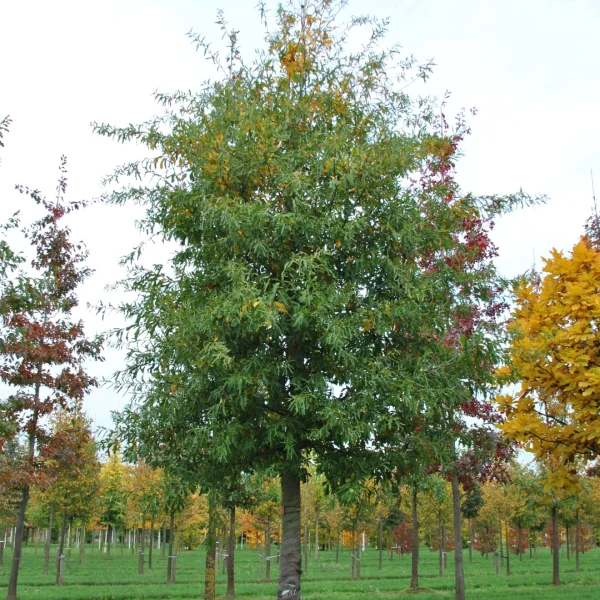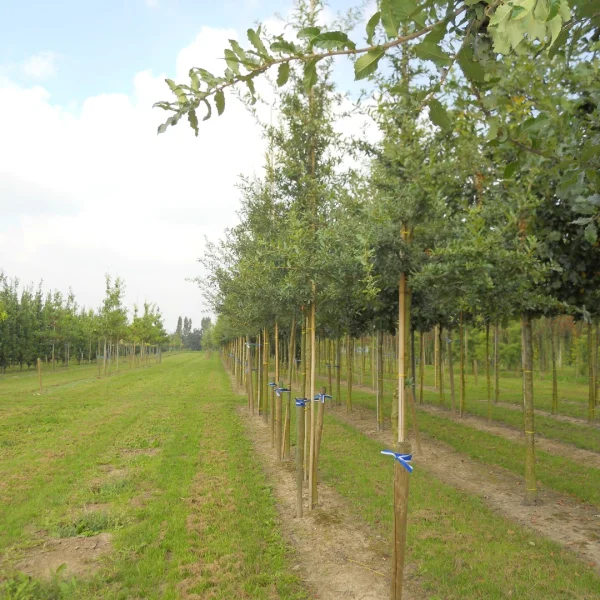Quercus phellos – Willow oak
Fagaceae
Quercus phellos – Willow oak
Se întâlnește în stare sălbatică în Statele Unite pe soluri umede, dar bine drenate. În zonele calde, este semicaducă sau complet caducă, iar în zonele reci, de obicei caducă. În habitatul său natural are o înălțime de până la 30 m, în cultură 15-20 m. Scoarța netedă de culoare gri închis devine ușor aspră la exemplarele bătrâne, slăbindu-se în plăci mici. Lăstarii tineri, de culoare verde-oliv, sunt pufoși, dar în curând devin goi și de culoare verde-maronie. Frunza este îngust lanceolată până la uneori liniară și seamănă foarte mult cu cea a salciei. Are o lungime de 5 - 15 cm și o lățime de 1 - 1,5 cm. Verde închis pe partea superioară, verde-albăstrui pe partea inferioară. Marginea intactă a frunzei este ușor ondulată. În zonele în care frunzele cad iarna, culoarea de toamnă este galben deschis. Ghindele mici sunt înglobate în cel mult o treime de nap.
Availability
Specifications
Download PDF
Height
15 - 20 (30) m
Width
10-12m
Crown
broad ovoid, dark, dense crown
Bark and branches
grey, smooth, later with flaky platelets, twigs olive-green
Leaf
lanceolate, smooth-edged, green, 5 - 15 cm
Flowers
gold-coloured ♂ catkins, May
Fruits
practically round acorns, Ø 1 - 1.5 cm
Spines/thorns
None
Toxicity
usually not toxic to people, (large) pets and livestock
Soil type
moist, nutritious
Soil moisture
suitable for wet soil
Paving
tolerates no paving
Winter hardiness zone
6b (-20,5 to -17,8 °C)
Wind resistance
good
Other resistances
resistant to frost (WH 1 - 6), can withstand wind, resistant to de-icing salt
Application
avenues and broad streets, industrial areas
Shape
clearstem tree, multi-stem treem
Origin
central and south-eastern part of North America
Possibly of interest
Frequently asked questions
Quercus phellos
Quercus phellos can eventually reach a height of 15 - 20 (30) m, depending on the site and climate conditions.
Quercus phellos has a average growing and can eventually reach a height of 15 - 20 (30) m, depending on the site and climate conditions.
The right time to plant Quercus phellos is during the dormancy period. In Western Europe, Quercus phellos with root balls can generally be planted from mid-November to late April, although this depends strongly on the climatic conditions and the species of tree.
may.
General
 English
English
 English (United Kingdom)
English (United Kingdom)
 Nederlands
Nederlands
 Nederlands (België)
Nederlands (België)
 Deutsch
Deutsch
 français
français
 čeština
čeština
 polski
polski
 español
español
 română
română
 dansk
dansk
 svenska
svenska
 magyar
magyar
 Türkçe
Türkçe
 slovenčina
slovenčina
 русский
русский
 norsk
norsk









